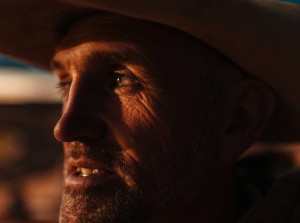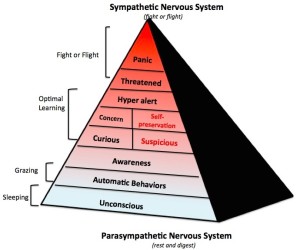West Taylor, owner of Wild West Mustang Ranch and a certified and award-winning TIP trainer, recently spent time with 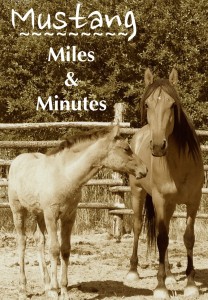 Raechel Nelson and her four-year old mustang, Alita. Taylor also visited with Dr. Steve Peters to discuss Evidence-Based Horsemanship, and the neuroscience behind Taylor’s horse work. Read more about Taylor here.
Raechel Nelson and her four-year old mustang, Alita. Taylor also visited with Dr. Steve Peters to discuss Evidence-Based Horsemanship, and the neuroscience behind Taylor’s horse work. Read more about Taylor here.
Taylor worked with Alita as part of the Mustang Miles & Minutes training feature. BestHorsePractices talked with Taylor, Nelson and Peters after two ground-breaking sessions.
Read comments from Nelson and Peters here.
West Taylor:
We started by converting the round pen into a square pen with panels. It’s 24 x 24 feet square. And it’s square on purpose. They have to figure out how to negotiate it. Every 24 feet, they have to make a decision. To start, they bury themselves in that corner, to get away. I just keep working until we can make it around without hiding, getting defensive, climb out of the panels.
I want to do it as soft as I can, but the horse has to make a decision. It really turns into me having some value. It turns into this thing over here (me) seems to be in charge. They start to figure those corners out.
The results for me are 10 times faster than with round pen.
In a round pen, it’s easy for a horse to trip into instinct mode and run for miles. A square pen, every 24 feet they are making a decision. You can just see their brains just crashing with just a little bit of pressure. I’m thinking: C’mon find the way out. Find the answer.
It might take 45 minutes. But then that’s it. Within three sessions, I can be touching them, rubbing on them. At first, I don’t even ask them to face up to me. I just want both eyes on me.
With Alita, I was in there, tossing a rope on her. My approach was that I’d want to keep a rope on her until she looked at me 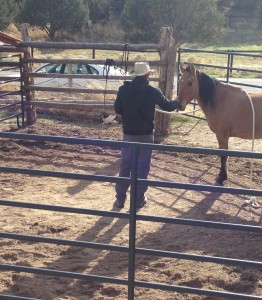 with both eyes. At some point she’s going to have to look at me, even for a split second, even when she turns. I want to build on that. As soon as she puts both eyes on me, I’m going to release. That rope on her is going to just die.
with both eyes. At some point she’s going to have to look at me, even for a split second, even when she turns. I want to build on that. As soon as she puts both eyes on me, I’m going to release. That rope on her is going to just die.
If she can’t look at me, I can’t trust her. If that pressure is too much for her, then I can’t come in on her side. She might at first just pretend. But I want her to:
- bend regularly
- drop her head.
- lick and chew.
I want to give her the time to do those things. I want to build her comfort level. I want her to say, ‘I can handle this for just a little be longer and then it’s going to go away. Ah, then it’s going to feel good.‘
I want her trust herself a little bit longer, a bit longer.
The sessions with Alita were wonderful. Steve and Raechel enjoyed what was happening. The horse really came through and showed its true colors. It was a great day.
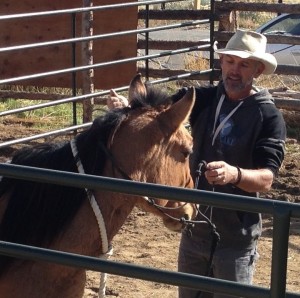 I was able to set the horse up in a safe environment where I could apply enough pressure to get that junk (aggression, fear, etc.) out. Get it out. Let’s deal with it. I don’t want to scratch on it, cover it up, and gloss it over. Then it’ll still be in there and some day it will crack.
I was able to set the horse up in a safe environment where I could apply enough pressure to get that junk (aggression, fear, etc.) out. Get it out. Let’s deal with it. I don’t want to scratch on it, cover it up, and gloss it over. Then it’ll still be in there and some day it will crack.
I want to find it. Dig deep. Get it out so the horse can feel more comfortable, so that it can think about relaxing and not think about dying.
A lot of new mustang owners may think they have worked through it, but they know they are avoiding it. They may not even say that out loud. But I can just see in their faces when I start working: ‘oh, boy, this is everything I’ve been avoiding. It’s going to be horrific.’
And then, it’s not horrific. We get through the process and at the end they are amazed at how their horse did. They’d never given the horse the opportunity to be
a super star and figure it out. They always held them in this space of ‘don’t do that’ or ‘don’t do this.’ ‘Let’s not get the horse upset.’ So, the horse can never be awesome. The horse is held mentally in a space where a little ticking bomb is going to go off.
Alita’s reactions matched up very well with the EBH pyramid. It was a beautiful mirror. As she went up that pyramid, we identified what was going on. Check out the EBH pyramid here.
